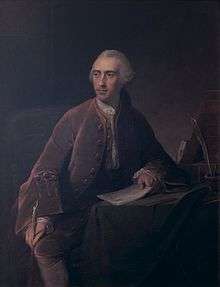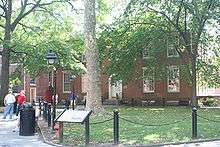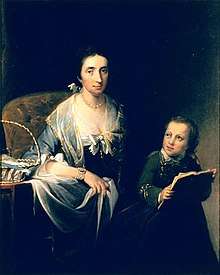Samuel Vaughan
Samuel Vaughan (1720–1802) was an English merchant, plantation owner, and political radical.

Early life
Vaughan was born in Ireland, the son of Benjamin Vaughan and Ann Wolf; he was the youngest of a family of 12.[1] He was a merchant and plantation owner, living largely in Jamaica, from 1736 to 1752, when he set up business as a merchant banker at Dunster's Court, Mincing Lane, in the City of London.[2][3]
Political activist
In politics Vaughan supported John Wilkes.[4] He sent his five sons to Warrington Academy,[5] Benjamin and William being taught by Joseph Priestley, with whom a strong family connection was forged.[6] In early 1769 Vaughan was using his contact with John Seddon of Warrington to circulate Wilkite literature in Lancashire.[7] He also hoped to recruit supporters in Manchester and Liverpool through Seddon.[8] With Joseph Mawbey and others, Vaughan was a founder of the Bill of Rights Society (Society of Gentlemen Supporters of the Bill of Rights).[9] It was a trust giving financial support to Wilkes, and the treasurers were Vaughan, Richard Oliver and John Trevanion (1740–1810). The Society set about dealing with Wilkes's tangled money affairs.[10]
Vaughan belonged to what Benjamin Franklin fondly called the Club of Honest Whigs, which met at St Paul's Coffee House in the cathedral churchyard[11] (see English coffeehouses in the 17th and 18th centuries). His support for the cause of Corsica in 1768 brought him the acquaintance of James Boswell through the Club.[12] Vaughan was a trustee of funds for Corsica, with William Beckford and Barlow Trecothick.[13]
In December 1774 Franklin and Josiah Quincy II stayed with Vaughan at Wanstead in Essex.[14] In the period 1781–2 the parliamentary reformer Christopher Wyvill met radical leaders at Vaughan's house.[15] There resulted a political pact for the following session of parliament, of mutual support between Wyvill and a radical group around Vaughan (including John Jebb, John Horne Tooke, and James Townsend).[16] Vaughan joined the Society for Constitutional Information in the 1780s.[17] Through William Beckford, he met the Earl of Shelburne. When Shelburne became Prime Minister, the Vaughan family influence reached foreign policy, trying to split the United States from their French allies in some ultimately unsuccessful moves of 1782.[18]
The Vaughan family was part of the Newington Green congregation of the dissenting minister Richard Price.[19] Samuel Vaughan was a friend of the elder William Hazlitt, the Unitarian minister.[20] Vaughan's religious views have been described as "free-thinking Unitarian".[21]
Jamaica and bribery scandal
Vaughan purchased in 1765 the post of Clerk to the Supreme Court of Jamaica. In 1769 Vaughan then offered the Duke of Grafton, a government minister, a sum of £5000 to secure a reversion, to hold this official place in the family for three of his sons.[2] Grafton brought a King's Bench case against Vaughan, which resulted in embarrassment to both parties. The prominence of the issue led the campaigning writer Junius to expose a previous sale of office by Grafton. This was the post of Collector of Customs in Exeter, to a Mr. Hine, for which Grafton took £3,500; and the implication was that the money went to a card-sharp.[22]
Vaughan put his side of the case in An Appeal to the Public on Behalf of Samuel Vaughan, Esq. in a fall and impartial Narrative of his Negotiation with the Duke of Grafton;[2] and Grafton dropped the prosecution.[23] Even so, Vaughan's actions appeared to be a political gaffe to some of the political radicals, Vaughan's allies. Anna Laetitia Barbauld, a family friend, wrote a poem complimenting his wife Sarah as a gesture of support.[24]
Some of Vaughan's sons became involved in the plantation business, and its London end Vaughan & Co. Benjamin visited the Colony of Jamaica in the early 1770s, and in parliament in the 1790s defended slavery on the island. William worked in the company, and became prominent in the London Society of West India Merchants.[21] Vaughan himself visited Jamaica again in 1775.[25] The Vaughan estates were Flamstead and Vaughansfield in Saint James Parish, slave-run sugar plantations.[26] Vaughansfield was involved in the Second Maroon War in the neighbouring Trelawny Parish.[27] Samuel Vaughan junior became proprietor of these estates.[21]
In the United States
After the end of the American War of Independence Vaughan made several long stays in the United States. There were three separate visits.[28] Vaughan was accompanied by his family, but sent them home in 1786.[29] He wrote to Richard Price in 1785 of the American principles of government as being "the permanent security of the rights of mankind".[30]
Philadelphia and Virginia
Vaughan was on good terms with George Washington;[31] Washington wrote to him on 30 November 1785 about gifts of a pamphlet of Mirabeau on the Society of the Cincinnati, and Jamaican rum.[32] They had met in Philadelphia in December 1783. There Vaughan planned the planting of the State House garden, as well as laying out the gardens of Gray's Ferry Tavern in the English style.[33][34] In Philadelphia also, with Francis Hopkinson, he helped revive the American Philosophical Society; and provided a sketch-plan for Philosophical Hall.[35][36]
As Vaughan explained to Humphry Marshall, he planned to plant the State House Yard with a representative collection of American trees and shrubs.[37] The ambition was a political statement, on the unity of the newly United States, and was shared by Washington and Thomas Jefferson as gardeners.[38] In Philadelphia for the Constitutional Convention during the summer of 1787, Vaughan paid a visit in July to William Bartram's nursery, from which he ordered 55 species of plants.[33][39] The State House project's greater scope was abandoned, but Vaughan saw to the publication of Marshall's Arbustum Americanum, in 1785.[40] He was elected a Fellow of the American Academy of Arts and Sciences in 1786.[41]
In 1787 also, Vaughan visited Mount Vernon, and drew a plan of the garden.[42] He gave Washington a marble mantelpiece for the house.[29]

Maine
Vaughan also spent time in Hallowell, Maine, meeting up with William Hazlitt there in the winter of 1784–5.[43] Sarah Vaughan had inherited property on the Kennebec River, from her father, who was a "Kennebeck Proprietor", and also a congregationalist supporter of the Brattle Square Church.[44][45][46] Two of the Vaughan sons (Benjamin and Charles) settled there, and another (John, a business partner of Robert Morris) at Philadelphia.[47][48] Samuel Vaughan in fact intended a religious project in the area, which was put in the hands of Charles, who became a "Kennebeck Proprietor"; but the original aim became muted as Charles's lack of business acumen showed through.[46]
Later life
In 1790 Vaughan attended the funeral of his friend Benjamin Franklin. Shortly afterwards he returned to London.[29] In 1792 he went to Paris to attend debates of the National Assembly.[49] In 1795 he bought the "Vaughan portrait", one of many portraits of Washington by Gilbert Stuart.[50]
_A33850.jpg)
Vaughan died in Hackney, in 1802.[51]
Family
Vaughan married Sarah Hallowell (1727–1809), daughter of Benjamin Hallowell. They had 11 children in all.[3] Ten lived to be adults. Their sons were:
- Benjamin
- William
- John Vaughan (wine merchant) (1756–1841)
- Charles (1759–1839), married Frances Western Apthorp.[47][52]
- Samuel junior (1762–1827)

Their daughters were
- Anne, or Ann, who married John Darby and was mother to John Nelson Darby[53][54]
- Rebecca married John Merrick, and was mother of Samuel Vaughan Merrick.[55][56]
- Barbara Eddy, Sarah, Hannah.[57]
References
- Jenny Graham (2000), The Nation, the Law, and the King: Reform Politics in England, 1789–1799, 2 volumes
Notes
- Cultural Landscape Foundation, Biography of Samuel Vaughan.
- James Boswell (1997). The general correspondence of James Boswell, 1766–1769: 1768–1769. Vol. 2. Edinburgh University Press. p. 239 note 1. ISBN 978-0-7486-0810-2. Retrieved 18 May 2013.
- Henry Laurens (1 April 1980). The Papers of Henry Laurens, Volume 8: October 10, 1771 – April 19, 1773. Univ of South Carolina Press. p. 327 note 6. ISBN 978-0-87249-385-8. Retrieved 18 May 2013.
- Peter D. G. Thomas (28 March 1996). John Wilkes: A Friend to Liberty. Oxford University Press. p. 112. ISBN 978-0-19-820544-9. Retrieved 17 May 2013.
- Ben, 1766–73; William, 1766–69; John, 1772–74; Charles, 1775–77; Samuel, 1777–79. (Dissenting Academies Online: http://dissacad.english.qmul.ac.uk).
- Graham, p. 103.
- William McCarthy (23 December 2008). Anna Letitia Barbauld: Voice of the Enlightenment. JHU Press. p. 99. ISBN 978-0-8018-9016-1. Retrieved 18 May 2013.
- Graham, p. 98 note 229.
- George Rudé (1971). Hanoverian London: 1714–1808. University of California Press. p. 173. ISBN 978-0-520-01778-8. Retrieved 18 May 2013.
- Jones, Nicola. "Society of Gentlemen Supporters of the Bill of Rights". Oxford Dictionary of National Biography (online ed.). Oxford University Press. doi:10.1093/ref:odnb/73620. (Subscription or UK public library membership required.)
- Robert E Schofield (2004). "The" Enlightened Joseph Priestley: A Study of His Life and Work from 1773 to 1804. Penn State Press. p. 18. ISBN 978-0-271-04624-2. Retrieved 17 May 2013.
- Verner W. Crane, The Club of Honest Whigs: Friends of Science and Liberty, The William and Mary Quarterly Third Series, Vol. 23, No. 2 (Apr. 1966), pp. 210–233, at p. 228. Published by: Omohundro Institute of Early American History and Culture. Stable URL: https://www.jstor.org/stable/1922508
- William McCarthy (23 December 2008). Anna Letitia Barbauld: Voice of the Enlightenment. JHU Press. p. 578 note 10. ISBN 978-0-8018-9016-1. Retrieved 18 May 2013.
- Josiah Quincy (1 June 2009). Memoir of the Life of Josiah Quincy, Jun. of Massachusetts. Applewood Books. pp. 252–3. ISBN 978-1-4290-1688-9. Retrieved 18 May 2013.
- E. C. Black (1963). The Association: British Extra-parliamentary Political Organization, 1769–1793. Harvard University Press. p. 84. ISBN 978-0-674-05000-6. Retrieved 18 May 2013.
- John M. Norris (1963). Shelburne and Reform. Macmillan. p. 162.
- Graham, p. 43 note 39.
- John M. Norris (1963). Shelburne and Reform. Macmillan. pp. 58 and 165.
- amphilsoc.org, John Vaughan papers, 1768 – Circa 1936.
- Wu, Duncan. "Hazlitt, William". Oxford Dictionary of National Biography (online ed.). Oxford University Press. doi:10.1093/ref:odnb/95498. (Subscription or UK public library membership required.)
- David Beck Ryden (2009). West Indian Slavery and British Abolition. Cambridge University Press. p. 64. ISBN 9780521486590.
- Bernard Falk (1950). The Royal Fitz Roys. Hutchinson. p. 108.
- Richard Lee Bradshaw (12 August 2011). Thomas Bradshaw (1733–1774): A Georgian Politician in the Time of the American Revolution. Xlibris Corporation. p. 90. ISBN 978-1-4653-4479-3. Retrieved 18 May 2013.
- Harriet Guest (1 December 2000). Small Change: Women, Learning, Patriotism, 1750–1810. University of Chicago Press. p. 233 note 27. ISBN 978-0-226-31052-7. Retrieved 20 May 2013.
- Proceedings, American Philosophical Society (vol. 116, No. 3, 1972). American Philosophical Society. p. 270 note 9. ISBN 978-1-4223-7123-7. Retrieved 19 May 2013.
- Lady Maria Nugent (2002). Lady Nugent's Journal of Her Residence in Jamaïca from 1801 to 1805. University Press of the West Indies. p. 242. ISBN 978-976-640-128-3. Retrieved 20 May 2013.
- Michael Craton (2009). Testing the Chains: Resistance to Slavery in the British West Indies. Cornell University Press. p. 214. ISBN 978-0-8014-7528-3. Retrieved 20 May 2013.
- John Hannibal Sheppard (1865). Reminiscences of the Vaughan Family: And More Particularly of Benjamin Vaughan, LL.D. D. Clapp & son, printers. p. 31. Retrieved 20 May 2013.
- Graham, p. 60.
- Graham, p. 51.
- William Meade Stith Rasmussen; Robert S. Tilton (1999). George Washington—the Man Behind the Myths. University of Virginia Press. p. 205. ISBN 978-0-8139-1900-3. Retrieved 17 May 2013.
- John Clement Fitzpatrick, David Maydole Matteson (editors), The Writings of George Washington from the Original Manuscript Sources, 1745–1799; prepared under the direction of the United States George Washington Bicentennial Commission and published by authority of Congress vol. 28 (1931), pp. 326–328; archive.org.
- Andrea Wulf (2 April 2012). The Founding Gardeners: How the Revolutionary Generation Created an American Eden. Windmill Books. p. 84 and note. ISBN 978-0-09-952562-2. Retrieved 20 May 2013.
- Hans Huth (1957). Nature and the American: three centuries of changing attitudes. U of Nebraska Press. p. 59. ISBN 978-0-8032-7247-7. Retrieved 20 May 2013.
- Edward Clark Carter (1993). "One Grand Pursuit": A Brief History of the American Philosophical Society's First 250 Years, 1743–1993. 1743–1993. American Philosophical Society. p. 16. ISBN 978-0-87169-938-1. Retrieved 19 May 2013.
- Proceedings, American Philosophical Society (vol. 116, No. 3, 1972). American Philosophical Society. p. 270. ISBN 978-1-4223-7123-7. Retrieved 19 May 2013.
- specialcollections.nal.usda.gov, Vaughan to Marshall, May 28, 1785, USDA History Collection.
- Andrea Wulf (2 April 2012). The Founding Gardeners: How the Revolutionary Generation Created an American Eden. Windmill Books. pp. 118–9. ISBN 978-0-09-952562-2. Retrieved 20 May 2013.
- Andrea Wulf (2 April 2012). The Founding Gardeners: How the Revolutionary Generation Created an American Eden. Windmill Books. p. 79. ISBN 978-0-09-952562-2. Retrieved 20 May 2013.
- Joseph Ewan, Seeds and Ships and Healing Herbs, Encouragers and Kings, Bartonia No. 45 (1978), pp. 28–29. Published by: Philadelphia Botanical Club. Stable URL: https://www.jstor.org/stable/41609821
- "Book of Members, 1780–2010: Chapter V" (PDF). American Academy of Arts and Sciences. Retrieved 28 July 2014.
- Andrea Wulf (2 April 2012). The Founding Gardeners: How the Revolutionary Generation Created an American Eden. Windmill Books. p. 24. ISBN 978-0-09-952562-2. Retrieved 20 May 2013.
- George Willis Cooke (31 December 2007). Unitarianism in America: A History of Its Origin and Development. Echo Library. p. 51. ISBN 978-1-4068-4830-4. Retrieved 20 May 2013.
- Properly, one of The Proprietors of the Kennebec Purchase from the late Colony of New-Plymouth.
- Gordon E. Kershaw (1975). The Kennebeck Proprietors: 1749–1775. New Hampshire Publishing Co. pp. 28–30 and 240. ISBN 978-0912274492.
- Alan Taylor (1990). Liberty Men and Great Proprietors: The Revolutionary Settlement on the Maine Frontier, 1760–1820. UNC Press Books. pp. 34–7. ISBN 978-0-8078-4282-9. Retrieved 20 May 2013.
- Arlington and Mount Vernon 1856. As Described in a Letter of Augusta Blanche Berard, The Virginia Magazine of History and Biography Vol. 57, No. 2 (Apr. 1949), pp. 140–175, at p. 169. Published by: Virginia Historical Society. Stable URL: https://www.jstor.org/stable/4245617
- Charles Rappleye (2 November 2010). Robert Morris: Financier of the American Revolution. Simon & Schuster. p. 368. ISBN 978-1-4165-7286-2. Retrieved 20 May 2013.
- Graham, p. 344 note 10.
- nga.gov, George Washington (Vaughan portrait).
- John Towill Rutt (1831). Life and correspondence of Joseph Priestley, LL.D., F.R.S., &c. R. Hunter. p. 59 note. Retrieved 2 June 2013.
- Alan Taylor (1990). Liberty Men and Great Proprietors: The Revolutionary Settlement on the Maine Frontier, 1760–1820. UNC Press Books. p. 35. ISBN 978-0-8078-4282-9. Retrieved 17 May 2013.
- Proceedings, American Philosophical Society (vol. 116, No. 3, 1972). American Philosophical Society. p. 270 note 8. ISBN 978-1-4223-7123-7. Retrieved 19 May 2013.
- Stunt, Timothy C. F. "Darby, John Nelson". Oxford Dictionary of National Biography (online ed.). Oxford University Press. doi:10.1093/ref:odnb/7141. (Subscription or UK public library membership required.)
- Daniel Raynes Goodwin (1862). Memoir of John Merrick, Esq. Henry B. Ashmead, book and job printer. p. 7. Retrieved 18 May 2013.
- Pennsylvania Biographical Dictionary. North American Book Dist LLC. 1 January 1999. p. 150. ISBN 978-0-403-09950-4. Retrieved 18 May 2013.
- masshist.org, Vaughan Family Papers 1768–1950, Guide to the Collection.
External links
- The Vaughan Family: NEHGS (June 1994). The New England Historical and Genealogical Register 1865. Heritage Books. p. 343. ISBN 978-1-55613-976-5. Retrieved 18 May 2013.